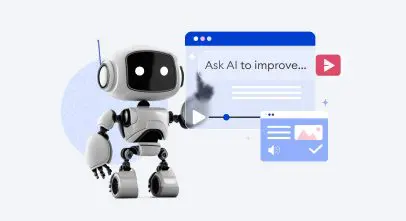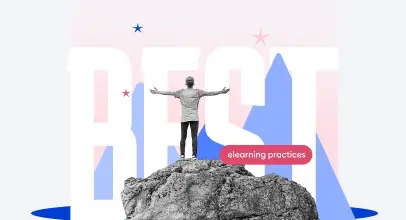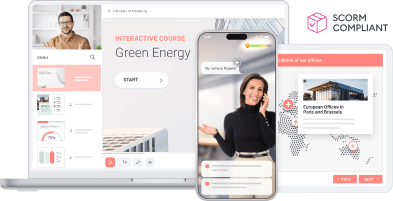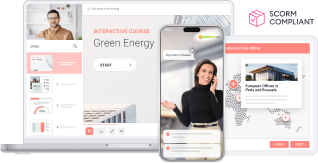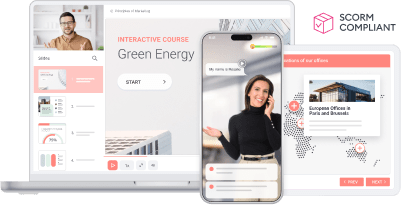The 5 biggest mistakes in designing eLearning – and how to avoid them

Lately, I’ve been hearing from clients that their learners prefer face-to-face training and want to avoid asynchronous eLearning. They’re making this claim despite the many advantages of eLearning, including being able to reach dispersed audiences, taking less time than face-to-face instruction, and allowing participants to complete training on their own time and at their own pace.
When I push back on this stated preference, what I hear is that clients are often reacting to eLearning that has been poorly designed. Of course they’d prefer in person training to eLearning that is basically just a PowerPoint slide.

1. Creating text-based content
What’s the problem?
eLearning that requires learners to read paragraphs of text, often without audio narration, or eLearning whose main purpose is to transmit a lot of information.
Why is it a problem?
Wait. Isn’t transmitting information what eLearning is for? Not entirely. eLearning is great for interactive training that learners can complete when and where they need it, but don’t mistake it for a repository for sharing information, especially text-based information. There are so many other ways to share that sort of content – job aids, manuals, websites, articles, or podcasts.
How do you know if your program has too much text? Here are some common signs:
- Learners have to scroll down to read everything on a given screen
- More than 50% of the eLearning time is reading text, or listening to text being read
- The only interaction is a quiz or “Check Your Knowledge” activity at the end of the program
- It is longer than 20 minutes
There are fewer excuses these days for content to be text-based, or information-heavy. With branching, eLearning can provide guided role-play situations. With AI, learners can participate in simulations, including on topics that previously weren’t considered possible in an online environment, like coaching or difficult conversations. Some eLearning platforms allow learners to participate in polls and to get immediate feedback on how their responses stack up against others who’ve completed the program. Doesn’t that sound better than a text-heavy program?
The solution
Just because you can turn almost any topic into eLearning doesn’t mean it’s the best instructional solution. Overall, you want to utilize the format that is best for its function. If the content is text-based, try a format that is also text-based. If your eLearning exists just to transmit information, try other on demand resources that might deliver the same benefits but that will be easier to maintain. (And don’t just swap out your text-based training for video. Talking head videos can be equally – or more – problematic.)
Choosing the right content for the right format is a key place we add value as instructional designers. Consider it carefully.
Example
In the example below, an infographic, shown on the left, is more appropriate and engaging, than a text-heavy eLearning with information on the screen or spoken aloud. Creating eLearning with less text – that integrates more practice and interaction – and less text, can be more challenging for designers, but is better for learners. It also allows you to flex your creativity as a designer.
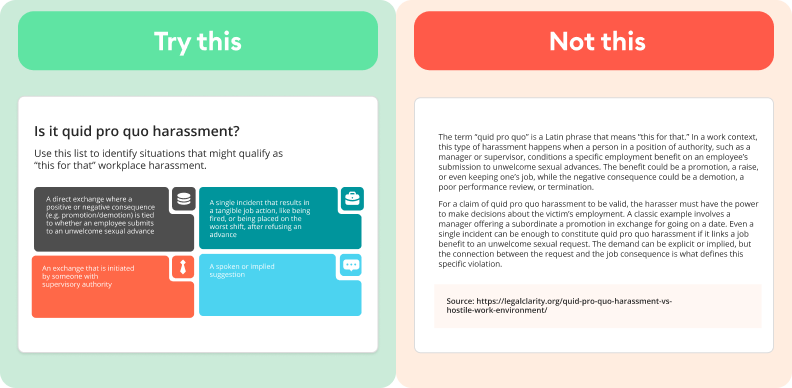
2. Mistaking clicks for interaction
What’s the problem?
eLearning where interaction is limited to clicking to advance the program or to reveal content.
Why is it a problem?
eLearning authoring tools are full of “interactions” that aren’t actually interactions that enhance learning. Interactive doesn’t just mean that there is some physical activity involved. Roger Courville, who’s been called “the Michael Jordan of online presentations and virtual classes,” suggests that online learning engage participants every four screens.
For a program to engage the brain and help encode content into long-term memory, it needs to allow for processing, reflection, thought, and practice. That engagement should be be an appropriately challenging question or situation every few minutes. Simply having users click on various parts of their screens might demonstrate that they haven’t left the room, but doesn’t mean they haven’t checked out.
The solution
Aim for highly interactive experiences that let learners exercise their brains. Provide appropriately challenging questions or situations for every few minutes that they are participating in your asynchronous course.
Example
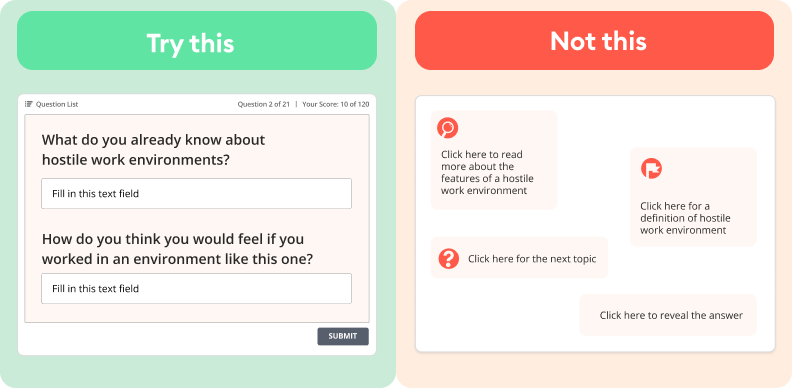
3. Testing content, rather than application
What’s the problem?
Test items that only ask participants to repeat back a piece of content that was just shared with them, rather than something that measures their ability to apply the content and demonstrate true learning.
Why is it a problem?
Benjamin Bloom created a widely recognized hierarchical framework that classifies learning activities according to their level of challenge and complexity. As one moves up the hierarchy – from the simplest level (recall of information and basic facts) to the more advanced levels (like application, analysis, or creation), one achieves higher levels of learning. Just being able to recite back some fact you just learned does not contribute to greater understanding, retention, or application. When eLearning assessment questions focus solely on reviewing what was just covered, as they often seem to be, they are not contributing to that greater comprehension.
Asking application questions ensures validity of your test items: They have what’s known as content validity because they represent a true summation of course content, rather than just focusing on the most recent information provided. They have construct validity because they more closely align to the knowledge and skill called for on the job. And they have reliability because it becomes less easy to guess the correct answer.
The solution
Designing valid and reliable learner assessments is a huge topic about which much has been written and discussed. Getting up-to-speed on the principles of good test construction is critical, especially if results are being used to gauge the effectiveness of your training, or of your participants’ learning, as it often is in eLearning situations. And even before you delve more deeply into the topic, you’ll have significantly better results if you just remember that a test item simply asks a question, while a good test item measures a learner’s ability to apply the content and demonstrate true learning.
Example

4. Not customizing the experience
What’s the problem?
eLearning that must be completed sequentially and uniformly by all learners.
Why is it a problem?
One of the best use cases for eLearning is its ability to provide branched learning paths. When you can expose learners to different content depending on their prior knowledge and expertise, their role, and, sometimes, their motivation, you are creating relevant, customized learning opportunities that will be more likely to “stick.”
The best design – whether synchronous (in person or virtual) or asynchronous – has modifications for learners. Think of a group exercise class where an exercise is presented, along with adaptations participants can make if it is too easy or too challenging. The same is true for work-related training: Some learners need scaffolding – supports – to help them accomplish a task or activity, while others can breeze through it and need more advanced material. eLearning is perfectly suited to provide this sort of customized approach, but only if it’s used.
The solution
A pretest will help determine a path through the program for unique learners. Start with a well designed test that provides feedback on the items the learner answered correctly (just in case their correct answer was a guess) and that directs them to content in the areas where they struggled. Activity feedback can be prescriptive as well. Personalize feedback with hints and suggestions tailored to each user.
To create this customized experience means really knowing your target audience and their range of skills and experience. Conduct a thorough needs assessment, making sure their voices are heard. Also involve target audience members in the design of your program. They can help you assess whether your content is at the right level and where the pain points are that might require additional support for some learners.
Example
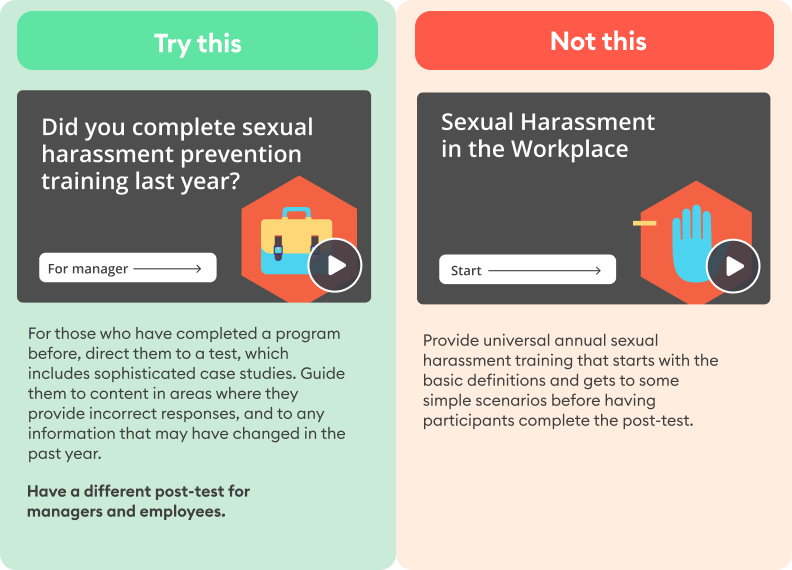
5. Locking down navigation
What’s the problem?
eLearning that offers no options for how to move through it; that is sequential from the first slide to the last. When participants must listen to all of the narration on one slide to advance to the next one. When participants must respond to every practice question. Or, when learners must review the majority of screens to be marked complete.
Why is it a problem?
Adult learners like to feel that they are trusted, responsible grown-ups. Training that limits their autonomy tends to decrease their motivation, at best, and sometimes to lose their focus or to have a negative response when they start to feel like they are back in grade school. Yes, some topics, particularly those related to safety or compliance, may require some amount of prescribed navigation, but a well-designed assessment may eliminate the need for learners to have to complete a program in lockstep with everyone else.
Additionally, eLearning, unlike live training, can serve as a refresher when learners forget what you’ve told them. As such, they should be able to get back into the program and easily locate the information they need in the moment without having to listen to the entire program to do so. How many slides they complete is less important than that they got to the ones they needed.
Similarly, forcing people to listen to all of the narration on a screen before being able to advance is also not a good user experience. What if the learner has turned on closed captions? People can read faster than it takes the narrator to talk and now they’d have to wait while that audio completes. Why?
Usually the answer to that why is because we don’t trust our learners to complete the training that they need to. Just-as-needed training is another potential benefit of eLearning, particularly if you have an eLearning library of elective topics. Participants should be able to log in or out of most eLearning programs as they see fit, and to be marked as complete when they feel they’ve mastered what they need to know.
The solution
Weigh adult learning considerations against the potential liability if they don’t listen to the entire program, to the entire slide, or if they don’t complete check your knowledge activities along the way. Then, make sure you have a prominent menu that lists the titles of each screen so that learners know exactly where to find things – like the index at the back of a book.
Example

Final Say
Avoid these five common mistakes when designing eLearning in order to reap its benefits and increase its positive reputation.
